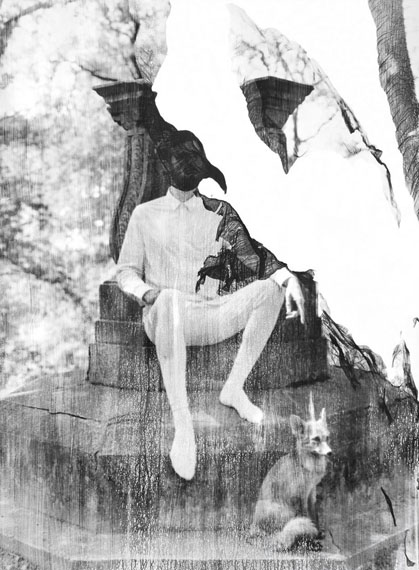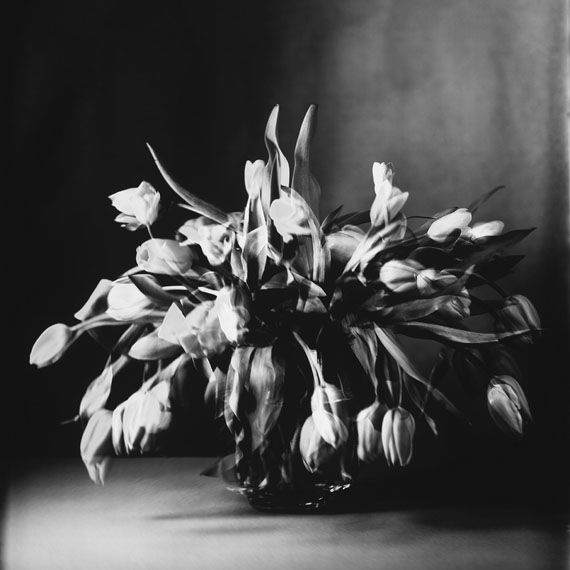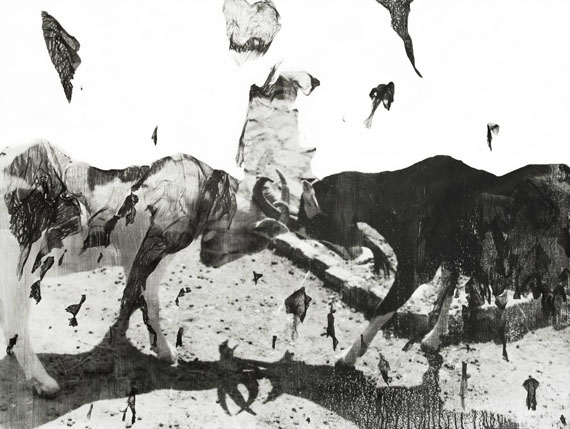
Fotografie, Fotoemulsion auf Aquarellpapier, Unikat, 2017
© Valentina Murabito
ANALOG
Susanna Kraus » Valentina Murabito »
Exhibition: 18 Jan – 3 Mar 2018
Thu 18 Jan 19:00 - 22:00

Galerie Benjamin Eck
Zieblandstr. 19
80799 München
+49-(0)152 33 52 49 57

© Kraus_Kohlmayer
"ANALOG"
Valentina Murabito and Susanna Kraus
Exhibition: 18 January – 3 March,2018
Opening: Thursday, 18 January, 7-10pm
Susanna Kraus and Valentina Murabito were known for their new discoveries in analogue photography. Their aesthetics and imagery are different, but they all agree that they work exclusively in black and white and unusually large formats. The gallerist Benjamin Eck will be showing around 10 works by Kraus and Murabito together for the first time.
The extraordinary thing about Valentina Murabito's (* 1981) photographic works is that she creates fantastical intermediates in the darkroom. In the exhibition she will present people with beaks ("The Blue Hour") or peaceful goats, who become fighting bulls, as in "Vite sacre". She draws inspiration from mythology and philosophy. Her discovery after 15 years of experimenting in the darkroom allows her to create these beautiful creatures. In the history of photography, it has only been possible to modify the surface by scratching, scratching, tearing or sewing. Murabito dissolves the photosensitive layer, i. Photo emulsion, from paper and reshaping. Something as impossible as photo paper and photo emulsion become one. In addition, the Italian photographer developed her works on different materials, such as wood, concrete, steel or entire walls and integrated, as a fresco in the church, in the architecture. In Munich, she will show works on wood, steel and large format watercolor paper. Valentina Murabito studied in Catania / Italy and Budapest / Hungary at the Kunsthochschule and today lives as a freelance artist in Berlin.
Susanna Kraus (* 1957) uses the world's only analogue direct image camera, the IMAGO Camera, which creates 1: 1 human images. The exhibition will only show works that, like the series "Alice", were created with the IMAGO Camera. In "Alice" Kraus interprets the search for the identity of the protagonist from "Alice in Wonderland". Together with Annegret Kohlmeyer, the artist removed flowers and plants from their surroundings and colors, turning them, as in "Tulips IV", into artificial objects full of intensity and gloom. Her father, Werner Kraus, invented the camera in 1970 on behalf of Daimler-Benz to include technical methods and further developed it with the sculptor Erhard Hößle. In the IMAGO camera, the photograph is created by direct exposure on a silver gelatin direct positive paper and on a scale of 1:1. Immediately after the exposure, the resulting original is developed in a chemical process.1978 the production of the paper was discontinued. In 2006, Susanna Kraus was able to convince ILFORD to reissue the direct positive paper and align it with her artistic needs. The exhibition shows prints of the original. Susanna Kraus studied at the renowned Otto Falckenberg drama school, played 25 years i.e in the Kammerspiele in Munich, before she learned the craft of IMAGO Camera as an autodidact. She continues to play in films and lives in Berlin.�

Fotografie, Fotoemulsion auf Aquarellpapier, Unikat, 2017
© Valentina Murabito
"ANALOG"
Valentina Murabito und Susanna Kraus
Ausstellung: 18. Januar bis 3. März 2018
Eröffnung: Donnerstag, 18. Januar, 19-22 Uhr
Susanna Kraus und Valentina Murabito wurden durch ihre jeweils neuen Entdeckungen in der Analogfotografie bekannt. Ihre Ästhetik und Bildsprache unterscheidet sich, aber sie eint, dass sie ausschließlich in schwarz/weiß und ungewöhnlichen großen Formaten arbeiten. Der Galerist Benjamin Eck zeigt erstmals je circa 10 Werke von Kraus und Murabito gemeinsam.
Das Außergewöhnliche an Valentina Murabitos (*1981) fotografischen Werken ist, dass sie in der Dunkelkammer fantastische Zwischenwesen kreiert. In der Ausstellung wird sie Menschen mit Schnäbeln ("Die Blaue Stunde") oder friedliche Ziegen, die zu kämpferischen Stieren werden, wie in "Vite sacre" präsentieren. Die Inspiration dazu schöpft sie aus der Mythologie und Philosophie. Ihre Entdeckung nach 15 Jahren Experimentieren in der Dunkelkammer ermöglicht es ihr, diese traumhaften Kreaturen zu schaffen. In der Fotografiegeschichte war es bisher nur möglich die Oberfläche, durch ritzen, kratzen, reißen oder vernähen zu verändern. Murabito löst die fotosensible Schicht, d.h. die Fotoemulsion, vom Papier und formt sie neu. Etwas bisher unmögliches, da Fotopapier und Fotoemulsion eins werden. Hinzukommt dass die italienische Fotografin ihre Werke auf unterschiedliche Materialien, wie Holz, Beton, Stahl oder ganzen Wänden entwickelt und so auch, wie ein Fresko in der Kirche, in die Architektur integriert. In München wird sie Arbeiten auf Holz, Stahl und großformatigen Aquarellpapier zeigen. Valentina Murabito studierte in Catania/Italien und Budapest/Ungarn an der Kunsthochschule und
lebt heute als freischaffende Künstlerin in Berlin.
Susanna Kraus (*1957) verwendet die weltweit einzige analoge Direktbildkamera, die IMAGO Camera, die 1:1 Abbildungen des Menschen schafft. In der Ausstellung werden nur Arbeiten, die wie die Serie "Alice" mit der IMAGO Camera entstanden sind, gezeigt. In "Alice" interpretiert Kraus die Suche nach der eigenen Identität der Protagonistin aus "Alice im Wunderland". Gemeinsam mit Annegret Kohlmeyer enthob die Künstlerin Blumen und Pflanzen ihrer Umgebung und Farben, wodurch sie, wie in "Tulpen IV", zu künstlichen Objekten voller Intensität und Düsternis werden. Ihr Vater, Werner Kraus, erfand die Kamera 1970 im Auftrag für Daimler-Benz zur Aufnahme technischer Verfahren und entwickelte sie mit dem Bildhauer Erhard Hößle weiter. Die Kamera funktioniert ohne Verwendung eines Negativs, d.h das Licht wird direkt auf das Papier gebannt. Jedes Bild wird so zu einem Unikat. 1978 wurde die Produktion des Papiers eingestellt. 2006 konnte Susanna Kraus ILFORD davon überzeugen, das Direktpositivpapier neu aufzulegen und nach ihren künstlerischen Bedürfnissen auszurichten. In der Ausstellung werden Abzüge vom Original gezeigt. Susanna Kraus lernte an der renommierten Otto Falckenberg Schauspielschule, spielte 25 Jahre u.a. in den Kammerspielen in München, bevor sie das Handwerk der IMAGO Camera als Autodidaktin erlernte. Sie spielt weiter in Filmen und lebt in Berlin.
�

IMAGOgramm, 62 x 200 cm
Silbergelatineabzug vom Unikat
auf Barytpapier, 2010
Susanna Kraus © Kraus_Kohlmayer